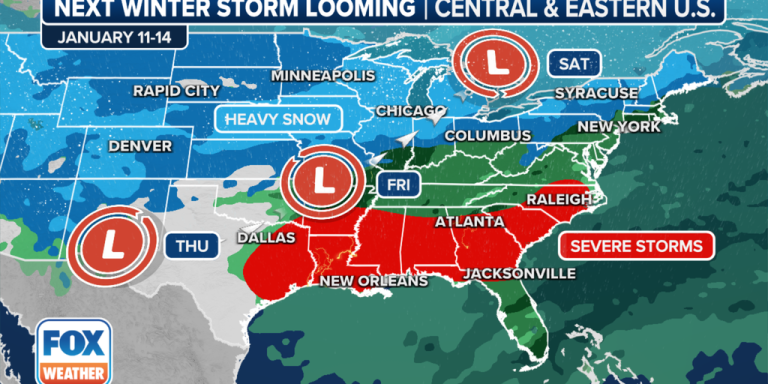Major storm system to produce blizzard conditions around the Great Lakes
Forecast models indicate snowfall amounts could reach more than a foot around the Great Lakes with winds of more than 40 mph.
A storm system over the Rocky Mountains and Southwest promises blizzard conditions and severe weather across the eastern half of the country over the next few days.
The Fox Forecast Center expects a band of heavy snow to fall from Missouri to Michigan, with the possibility of severe thunderstorms from Texas through the Carolinas and the mid-Atlantic.
Similar to the previous two storm systems, major cities in the Northeast will miss out on seeing accumulating snow, with temperatures too warm to support freezing precipitation along the coast, but it will be a much different story along the Great Lakes.
The storm coming across the country will sweep across the United States later this week and into the weekend. (Fox Weather)
The storm system has already produced blizzard conditions on some mountains in the Pacific Northwest and caused a deadly avalanche in California.
Major impacts are expected to begin late Thursday across the Plains and continue until the storm system pushes into Canada and off the East Coast on Saturday.
How to watch Fox Weather
Winter weather effects
Snowfall is expected to be lightest on the plains and its coverage and intensity will increase throughout the Great Lakes region.
The first flakes are expected to start flying Thursday, with Chicago, Detroit, Milwaukee and Indianapolis all seeing snow accumulation by Friday.
Forecast models show some communities in the Great Lakes region could pick up double-digit snowfall accumulations with wind gusts exceeding 40 mph.
The Chicago area was placed under a winter storm watch Thursday and local National Weather Service meteorologists warned of the potential for blizzard conditions in northeastern Illinois and northwestern Indiana Friday evening into Saturday morning.
Computer models show the heaviest snowfall will occur from northern Illinois through Wisconsin and Michigan, where more than a foot of new snow could reach.
Millions of residents from the Plains across the Great Lakes are under winter weather advisories.
The combination of heavy snow and gusty winds could make travel impossible along the I-80 corridor, with freezing rain making it as far south as Interstate 40.
Cities like Chicago and Detroit are poised to at least double this season's snowfall accumulations. The Windy City has reported only about 6 inches of snowfall since Dec. 1, and Detroit has only seen 1.1 inches of snow.
Where warm air will be prevalent, south of Interstate 40, communities will have a chance to see strong to severe storms.
El Niño appears to be on the verge of a rapid collapse
Severe weather effects
Another cross-country storm is bringing severe weather to the storm-weary South
Another strong storm system is expected to bring more severe thunderstorms, including possible tornadoes, to the South over the weekend. The area continues to collect debris after deadly storms tore through the area Monday and Tuesday.
NOAA's Storm Prediction Center (SPC) has highlighted areas to the south days before the actual storm system arrives, meaning certainty is high for threats of damaging winds and tornadoes on Thursday and Friday.
The highest threat area on Thursday is in eastern Texas, Arkansas, Louisiana and Mississippi. The SPC has placed this area at Level 2 out of 5 on its thunderstorm risk scale.
On Friday, the threat area is expected to advance eastward, extending from Mississippi through North Carolina.
Forecasters warn that given the instability available, the atmosphere could be ripe for the development of more supercell thunderstorms than we saw earlier in the week, which featured a more linear storm structure.
Detached cells are known to produce stronger tornadoes than those associated with squall lines, resulting in more widespread wind damage.
“Isolated thunderstorms are always a big concern because they can cause powerful tornadoes,” Merwin said. “It's like coming to a buffet and having one person. These separate thunderstorms can eat up all the energy in the atmosphere.”
Communities like Dothan, Alabama; Panama City, Florida; Clermont, North Carolina, which was hard hit during Tuesday's severe weather outbreak, was listed in the threat zone on Friday.
However, the SPC placed areas of southeastern Alabama and central Georgia, including Atlanta and the Carolinas, at level 3 out of 5 on its thunderstorm risk scale.
“But the subtropical jet, because of the El Niño phase, is allowing that ripping and rumbling to remain active to the south,” FOX Weather meteorologist Steve Bender said.
Deadly storms sweep through the South with widespread hurricane damage
Follows the arctic air
Behind the frontal boundary will be the coldest air of the season, with temperatures dropping to about 0 degrees as far south as Missouri and values reaching at least -30 degrees along the U.S.-Canada border.
As the next work week progresses, the polar air mass is expected to spread southward and eastward, but questions remain about the cold air's survival pattern.
The polar vortex is set to send an Arctic blast deep into us starting later this week
Will the cold air be able to stick around for a long time, or will the air mass moderate, providing just a quick winter hit?
These details will be important because if the cold air mass has staying power, the chances will increase that a future storm system will be able to take advantage and deliver snowfall in areas with historical deficits.

